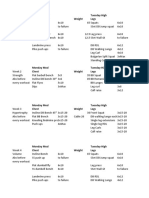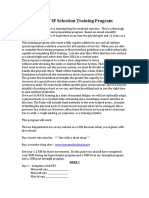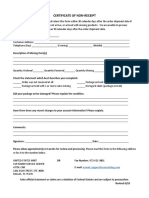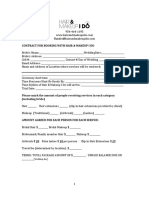Grand Review Packet Ap Exam
Grand Review Packet Ap Exam
Uploaded by
api-41164603Copyright:
Available Formats
Grand Review Packet Ap Exam
Grand Review Packet Ap Exam
Uploaded by
api-41164603Original Title
Copyright
Available Formats
Share this document
Did you find this document useful?
Is this content inappropriate?
Copyright:
Available Formats
Grand Review Packet Ap Exam
Grand Review Packet Ap Exam
Uploaded by
api-41164603Copyright:
Available Formats
AP HUMAN GEOGRAPHY THE GRAND REVIEW Unit I: Geography: Its Nature and Perspective Identify each type of map:
1.
2.
3. Match the following: 5. a computer system that stores, organizes, retrieves, analyzes, and displays geographic data the forms superimposed on the physical environment by the activities of humans
4.
a.
cultural diffusion
6.
b.
cultural ecology
7. 8.
the spread of an idea or innovation from its source interactions between human societies and the physical environment a space-based global navigation satellite system the physical environment, rather than social conditions, determines culture the small- or large-scale acquisition of information of an object or phenomenon, either in recording or real time
c. d.
cultural landscape environmental determinism
9. 10.
e. f.
GIS GPS
11.
g.
remote sensing
Choose the one that does not belong: 12. a. b. c. a. b. c. a. b. c. d. a. b. c. d. township and range clustered rural settlement grid street pattern site situation its relative location latitude and longitude site situation absolute location globalization nationalism foreign investment multinational corporations 16. a. b. c. d. e. a. b. c. d. a. b. c. d. major airport grid street pattern major central park natural harbor public sports facility Westernization uniform consumption preferences enhanced communications local traditions time zones China United States railroads 15 degrees
13.
17.
14.
18.
15.
Match the following (some regions have more than one answer): 19. 20. 21. formal region functional region vernacular region a. b. c. d. e. f. 22. The why of where refers to a. b. c. d. e. 23. geographys emphasis on landscape features. spatial patterns on the landscape. a definition of geography that is simply locational. the idea that the explanation of a spatial pattern is crucial. the depiction of a regions physical features. Milwaukee the Milwaukee Journal Sentinel Wisconsin the South an airline hub Rust Belt
Which of the following sets of maps would help explain how scale of inquiry affects truth? a. b. c. d. e. maps showing the area of France before and after surveying maps of Hudson Bay drawn by Native Americans and by the earliest European travelers maps showing Michigans population density by counties and the United States population density by state maps showing the number of auto thefts per block in Seattle in the decades before and after the Great Depression maps of gang graffiti in Philadelphia
Unit II: Population and Migration Label each of the following population pyramids as Stage 1, Stage 2, Stage 3, Stage 4 or Stage 5 of the demographic transition:
24. ________________________
25. ________________________
26. ________________________
27. ________________________
28. ________________________
29. ________________________
Label each of the following Detroit, MI; Laredo, TX; Lawrence, KS; Naples, FL; Unalaska, AK; or USA:
30. ________________________
31. ________________________
32. ________________________
33. ________________________ Match the following: 36.
34. ________________________
35. ________________________
the ability of a resource base to sustain its population a population shift from urban to rural areas the number of working-age people compared to the number of people too old or too young to work migration within a state migration between states the difference between in-migration and outmigration the process by which immigrants from a particular place follow others from that place to another place
a.
brain drain
37. 38.
b. c.
carrying capacity chain migration
39. 40. 41.
d. e. f.
counterurbanization dependency ratio external migration
42.
g.
infant mortality rate
43. 44. 45. 46.
flight of talented people away from an area CBR-CDR per thousand number of children a woman is likely to have number of deaths under the age of 2 per thousand
h. i j. k.
internal migration natural increase rate net migration total fertility rate
Choose the cause of the other two: 47. a. b. c. a. b. c. a. b. c. a. b. c. a. b. c. water population growth agriculture Columbus discovers America crops exchanged between the Western and Eastern hemisphere millions of Native Americans are killed by disease one-child policy poverty overpopulation poverty drug trafficking guest workers high standard of living large metropolitan population Stage 3 of the demographic transition
48.
49.
50.
51.
Choose the effect of the other two: 52. a. b. c. a. b. c. a. b. c. a. b. c. a. b. c. poverty war migration racism exclusion of non-white immigrants quota laws from the 1920s to the 1960s young age structure not married high level of migration cold weather warm coastal waters population clusters near the equator and the coast increased trade rich natural resources population cluster on the coast
53.
54.
55.
56.
Identify each of the following as a pull factor or a push factor: 57. 58. 59. 63. ethnic cleansing natural disaster available jobs 60. 61. 62. war chain migration overpopulation
Two-thirds of the worlds population is clustered in four regions. Which of the following is not one of these four regions? a. b. c. d. e. East Asia Southeast Asia Sub-Saharan Africa Europe South Asia
64.
Assuming a world population of 5,700,000,000 and an annual growth rate of 1.6 percent, how many people will be added to the worlds population in the next year? a. b. c. d. e. 912,000 9,120,000 91,200,000 912,000,000 9,120,000,000
65.
The population of the United States is approximately 300 million, and the land area is approximately 9 million square kilometers. The arithmetic density of the United States is approximately a. b. c. d. e. 30 square kilometers per person. 30 persons per square kilometer. 0.03 square kilometers per person. 0.03 persons per square kilometer. 300 persons per square kilometer.
66.
Which continent(s) is/are commonly associated with high numbers of refugees in the early twentyfirst century? I. II. III. IV. V. VI. a. b. c. d. Africa Asia Australia Europe North America South America I II I and II I, II, IV e. f. g. h. I, II, VI III and IV IV and V IV, V, VI
Unit III: Cultural Patterns and Processes Classify each of the following religions as monotheistic or polytheistic and ethnic or universalizing, and indicate their hearth region. religion 67. Buddhism 68. Hinduism 69. Islam 70. Judaism 71. Mormonism 72. Orthodox Christianity 73. Protestantism 74. Roman Catholicism Match the following: 75. 76. 77. 78. 79. 80. fragmentation of a region into smaller units a common language an example of ethnic nationalism an example of linguistic nationalism an example of linguistic fragmentation an example of how religion can influence geography minority branch of Islam but majority in Iraq and Iran architectural style that diffused from New England to the Great Lakes a. b. c. d. e. f. Balkanization Cape Cod feng shui Gaelic lingua franca Nunavut mono or polytheistic ethnic or universalizing hearth region
81.
g.
Scandinavian
82.
h.
Shiite
Identify each of the following as a centripetal force or a centrifugal force: 83. 84. 85. 86. uneven development substate nationalism linguistic homogeneity a strong tradition of local governance 87. 88. 89. 90. national symbols compact state fragmented state external threats
Classify each of the following as folk culture or popular culture 91. 92. 93. 94. 95. 96. 103. the Amish sports small scale large scale slow change rapid change 97. 98. 99. 100. 101. 102. relocation diffusion cultural homogeneity traditional diet McDonalds blue jeans modern communication
All of the following twentieth-century migration streams were propelled by persecution or open conflict EXCEPT a. b. c. d. e. Asians leaving Uganda. Kosovars leaving Yugoslavia. Tutsis leaving Rwanda. Hindus leaving Pakistan. Mexicans leaving Mexico.
104.
If four languages have similar words for numbers and the names of fish, but different names for a certain disease, what might be concluded about the time at which the disease first diffused? a. b. c. d. e. The disease spread among a population that later divided and evolved into four different languages. The population divided and evolved into the four different languages, and then the disease spread. The disease spread to two different populations that later divided into different languages. The disease and language spread to four different regions at the same time at the same rate. No conclusion is possible
105.
Which of the following correctly sequences the continuum from language family to dialect? a. b. c. d. e. Afro-Asiatic, Semitic, Arabic, Berber Sino-Tibetan, Sinitic, Mandarin, Chinese Indo-European, Indo-Iraman, Hindi, Bengali Indo-European, Baltic-Slavic, Russian, Ukranian Indo-European, Germanic, English, Midland-Northern
106.
Contact zones between religions are most likely to be volatile when they are a. b. c. d. e. inhabited by two major groups with divergent religious beliefs. made up of three or more religious groups. characterized by considerable interaction between religious groups. also language contact zones. associated with competing ethnonational claims to territory.
107.
________ is to Canada as ________ is to the United States. a. b. c. d. e. French; English French; Spanish presidential government; parliamentary government conflict over ethnicity; conflict over language northern hemisphere; southern hemisphere
108.
Mexico is I. II. III. IV. V a. b. c. d. the largest number of legal immigrants to the United States the largest number of illegal immigrants to the United States a member of NAFTA a member of the OAS predominantly Catholic II, V I, III, V II, III, V I, IV, V e. f. g. h. II, IV, V I, II, III, IV I, II, III, V I, II, III, IV, V
109.
Which of the following aspects of diffusion of Western culture threaten non-Western ways of life? I. II. III. IV. V. a. b. c. d. e. loss of traditional values subjugation of women Western control of media alteration of traditional landscapes pollution I and II I and III I, II, IV I, III, IV, V I, II, III, IV, V
Unit IV: Political Organization of Space 110. Put the following in order from the largest to the smallest: census tract, county, municipality, nation-state, province, empire
111.
G_______________, g_______________, g_______________
Match the following: 112. 113. 114. nation state multi-nation state multi-state nation a. b. c. Korea Japan Indonesia
Match the following: 115. 116. 117. 118. 119. 120. compact state elongated state prorupted state perforated state fragmented state landlocked state a. b. c. d. e. f. Afghanistan Indonesia Nicaragua South Africa Vatican City Vietnam
Match the following (some states have more than one answer): 121. 122. 123. 124. Brazil China Mesopotamia Taiwan a. b. c. d. was a hearth was a colony is a sovereign state has a forward capital
Match the following (some states have more than one answer): 125. 126. 127. 128. unitary state federal state confederal state devolution a. b. c. d. e. f. Canada France Germany Mexico Switzerland USA
Place the following colonial powers under the appropriate headings: Belgium, Britain, France, Germany, Italy, Netherlands, Portugal 129. Africa, 1850 130. Africa, 1900 131. Africa, 1950
Match the following: 132. model that demonstrates the transfer of resources from less developed to more developed areas the fringe of a state land beyond a border the node of a state an area the retains a distinction from a larger area manipulating boundaries for political gain an area rather than a line a. core-periphery
133. 134. 135. 136. 137. 138.
b. c. d. e. f. g.
enclave frontier gerrymandering heartland hinterland rimland
Label each boundary physical or cultural and give an example boundary 139. mountain physical or cultural example
140. language
141. religion
142. river
143. geometric
144. the Green Line
145.
The European Union, the Arab League, and the United Nations are all examples of a. b. c. d. e. pressure groups nation-states centrifugal organizations supranational organizations federations
146.
Which of the following has fostered the most significant economic growth by eliminating import tariffs between member states? a. b. c. d. e. European Union (EU) Organization of Petroleum Exporting Countries (OPEC) North Atlantic Treaty Organization (NATO) Association of Caribbean States (ACS) United Nations (UN)
147.
The provisions of the United Nations Conference on the Law of the Sea give coastal countries navigational and economic sovereignty over which of the following zones? a. b. c. d. e. twelve-nautical-mile territorial sea zone and part of the Arctic Circle export processing zone (EPZ) 200-nautical-mile exclusive economic zone empowerment zone continental shelf
148.
An increasing number of states have adopted a federal form of government primarily to a. b. c. d. e. grant different ethnicities or nationalities more effective representation. encourage the breakup of the superpower alliances. govern compact states more effectively. deploy scarce resources efficiently. meet all of the above needs.
Unit V: Agriculture and Rural Land Use Match the following: 149. 150. 151. terracing, Mediterranean agriculture, pastoralism terracing, shifting agriculture arid climate, irrigation, little pork production, pastoralism wheat, little pork production, pastoralism factory farms, large pork production wheat, Mediterranean agriculture maize, irrigation a. b. c. Egypt Greece Italy
152. 153. 154. 155.
d. e. f. g.
Peru Mexico Turkey USA
Choose the one that does not belong: 156. a. b. c. increases in the amount of land under cultivation increases in the agricultural workforce increases in the use of energy and technology
157.
a. b. c. a. b. c. a. b. c. d. a. b. c. d. e. a. b. c. d. e. a. b. c. a. b. c. d.
plantation farming hunting and gathering subsistence agriculture efficient transportation regionalized cuisine corporately controlled farms factory farms genetic engineering high food prices Green Revolution California Mediterranean agriculture happy cows sharecropping wheat soy beans coffee wheat corn rice beef railroad Milwaukee, 1900 hunting and gathering It is limited to tropical areas gender-based division of labor Stage 1 of the demographic transition
164.
a. b. c. d. e.
158.
Great Plains Native Americansbuffalo Eskimossnow Hawiianswigwams Wisconsin settlerslog cabins Great Plains settlerssod and thatch shifting agriculture tropical climate global warming depletion of soil commercial agriculture sustainable agriculture limited use of chemicals integration of crops and livestock use of pesticide resistant seed organic farms nomads pastoralism hunting and gathering subsistence agriculture shifting agriculture terracing
159.
165.
a. b. c. d. e. a. b. c. d. e. a. b. c. d. e. f.
160.
166.
161.
167.
162.
163.
168.
What is a milkshed and why is it important?
169.
Isolated farmsteads in the United States evolved as a result of all of the following EXCEPT a. b. c. d. e. political stability. colonization by individual pioneer families. agricultural private enterprise. government land policy. physical barriers preventing communal farm practices.
170.
Grain raised in the United States is used today primarily as a. b. c. d. e. human food. a source of fuel. livestock feed. an export to foreign countries. raw material for various industries.
171.
With respect to the relationship between culture, religion, and the physical environment a. b. c. d. e. few religions derive meaningful events from the physical environment. religious ideas may be responsible for some of the changes people make in the physical environment. religion is no longer an important source of identification for a distinct cultural group. all religions appeal primarily to people living in their land of origin. All of the above are true.
172.
A common difference(s) between farms in an LDC (like Pakistan) vs. farms in an MDC (like the United States) that grow the same crop is a. b. c. d. e. the amount of crop produced in a year the importance of the crop to the farmer the income derived from crops A and B A and C
Unit VI: Industrialization and Economic Development Label each of the following as bulk-reducing, bulk-gaining, footloose, or just-in-time: 173. 174. 175. 176. soft-drink bottling brewing nickel smelting baking 177. 178. 179. 180. automobile assembly autoparts manufacturing electronics manufacturing call centers
Label each of the following as primary, secondary, tertiary, or quaternary economic activity: 181. 182. 183. 184. 185. extract natural resources from the environment transform raw materials into finished products involve the collection, processing, and manipulation of information involve the exchange of goods and the provision of services involve the production of fresh produce for urban markets
Indicate the country or countries: 186. 187. 188. 189. 190. NAFTA highest consumption of fossil fuels per capita the Four Asian Tigers maquiladoras Atlantic-Pacific canal
Match the following: 191. 192. 193. 194. high terminal cost, high line cost, high route flexibility high terminal cost, low line cost, high route flexibility high terminal cost, low line cost, low route flexibility low terminal cost, high line cost, high route flexibility a. b. c. d. airplane railroad ship truck
Label the five stages of Rostows model and briefly describe the characteristics:
195. Stage 1
196. Stage 2
197. Stage 3
198. Stage 4
199. Stage 5
Assume a Stage 5 country and indicate if each of the following would be high or low: 200. 201. 202. standard of living CBR CDR 203 204. 205. NIR life expectancy literacy
206. 207.
GDP GEM
208. 209.
pollution job in the informal sector
Match the following: 210. 211. 212. 213. 214. 215. 216. banking, finance, insurance deforestation desertification ecotourism ozone depletion smog a. b. c. d. e. f. Brazil chlorofluorocarbons Mexico City national parks New York, London, and Tokyo Sahel
Which of the following arguments help explain why seventy-five percent of those employed in Export Processing Zones, such as maquiladoras, are women? I. II. III. IV. a. b. c. d. e. Women have better educational qualifications than men. Women are paid less than men. Many employers consider women to be more dexterous than men. Many employers consider women more likely to organize unions than men. I and III only II and III only II and IV only I, II, and III only I, II, III, and IV
217.
Which of the following has contributed most to the deindustrialization of regions like the English Midlands and the North American Manufacturing Belt? a. b. c. d. e. the increased percentage of women in the labor force competition from foreign imports environmental legislation the formation of free trade associations the decline of labor unions
218.
In recent decades, all of the following have played a major role in the rapid growth of Sun Belt cities of the United States EXCEPT a. b. c. d. e. immigration from Latin America. high levels of per capita federal spending in the South and West. cheap land and labor. climatic changes leading to colder northern winters. the increasing demand for retirement and resort centers.
219.
United Nations recognition of a states exclusive economic zone allows the state to a. b. c. d. e. establish economic free trade zones within the sovereign territory of other states. claim national economic jurisdiction over 200 nautical miles of water extending from its coast. limit importation of competitive goods and services from other countries. protect domestic production by imposing tariffs on all foreign-made products. form limited economic alliances with other countries.
220.
Contemporary manufacturing is characterized by a. b. c. d. e. production facilities that are generally located as close as possible to the sites of raw material production. strong unions and localized involvement in all facets of the production process. spatial disaggregation of the production process. reliance on highly skilled labor at all phases of the production process. production facilities located close to railroads.
Unit VII: Cities and Urban Land Use Label each country with either the rank-size rule or the primate city rule: 221. 222. 223. Canada France Germany 224. 225. 226. India South Korea United States
Choose the one that does not belong: 227. a. b. c. d. a. b. c. d. e. a. b. c. d. a. b. c. d. e. megalopolis core area Boston to Washington, D.C. Los Angeles to San Diego Brookfield Square edge city gentrification suburban sprawl white flight agglomeration business park decentralization edge cities blockbusting and racial steering redlining by financial institutions concentration of public housing fixed school district boundaries Economic Enterprise Zones 231. a. b. c. d. e. a. b. c. d. a. b. c. d. e. a. b. c. d. France Mesopotamia Mexico North China the Indus Valley world cities Chicago Mumbai Tokyo 500 B.C.defensive sites A.D. 1700water power A.D. 1800railroad junctions pre-1950navigable waterways post-1950--- highways urban Africa Asia South America
228.
232.
229.
233.
230.
234.
235.
Place the following in order from least recent to most recent: big box superstore, downtown business district, shopping mall, Internet
Match the following: 236. export primarily to consumers outside the settlement sell to people within the settlement basic industries minus non-basic industries related to talent related to the level of services provided center of Latin American cities provided to people by government downtown the presence of which greatly diminishes the attractiveness of site farther away illegal occupation of a residential district a. basic industries
237. 238. 239. 240. 241. 242. 243. 244.
b. c. d. e. f. g. h. i.
CBD central plaza economic base human capital intervening opportunities non-basic industries public housing squatter settlement
245. 246.
j.
urban hierarchy
Which of the following environmental issues is of most immediate concern to policy-makers in New England? a. b. c. d. e. overharvesting of breeding stock by commercial fishers oil-spill liability desertification by overgrazing of cattle intensification of urban heat islands generation of electric power by wind
247.
Which of the following was NOT a reason for rapid suburbanization in the United States after the Second World War? a. b. c. d. e. mass production of the automobile reduction in long-distance commuting expansion of home construction expansion of the interstate highway system availability of low down payment terms and long-term mortgages
248.
According to the rank-size rule, if the largest city in a country has a population of 10 million, the next largest city will have a population of a. b. c. d. e. 9 million. 8 million. 7.5 million. 5 million. 3.5 million.
249.
Today, most of the United States and Canadian population lives in which of the following? a. b. c. d. e. farming areas rural non-farming areas central cities metropolitan areas small towns
250.
Public transit is more extensive in Western European cities than in the United States primarily because a. b. c. d. e. Europeans cannot afford cars. European governments subsidize public transit. density is lower. the central city contains fewer high-rises. suburbs are built at subway terminals.
251.
The attraction of the call center industry to locate in India can best be explained by a. b. c. d. e. low wages and wide use of English. low wages and geographic situational factors. wide use of English and the large number of working students. Indian students' ability to work at night and geographic situational factors. none of the above.
252.
Historically, the growth of North American suburbs was most constrained by a. b. c. d. e. high land values. zoning ordinances. limited transportation. housing shortages. cultural preferences.
253.
In Latin America, data for employment in many large urban areas are most likely to be incomplete because a. b. c. d. e. employment is growing too rapidly. most people are unemployed. people change jobs regularly. records are kept mainly for male workers. many people work in the informal sector.
254.
Spreading parts production and fabrication among many countries or communities a. b. c. d. e. increases proximity to markets. increases large corporations bargaining power with local governments and labor. decreases the unequal distribution of industry. leaves unmet consumer demand. reduces transportation distances.
Models You Need to Know Label each of the following models and explain how each can be useful to geographers. 255.
256.
257.
258.
259.
260.
You might also like
- Reskin For Jujutsu Craft 2Document7 pagesReskin For Jujutsu Craft 2exedrul100% (1)
- Plaza Master June 2023Document56 pagesPlaza Master June 2023WarlordNo ratings yet
- Chapter 3 TestDocument6 pagesChapter 3 Testapi-411646030% (1)
- When Graduation’s Over, Learning Begins: Lessons for STEM Students and ProfessionalsFrom EverandWhen Graduation’s Over, Learning Begins: Lessons for STEM Students and ProfessionalsNo ratings yet
- Agreement For SaleDocument8 pagesAgreement For SaleAlisham VnktshNo ratings yet
- SORL DEP Workout Phase 1 and 2Document31 pagesSORL DEP Workout Phase 1 and 2Aj Foraker100% (1)
- Bodybuilding For The Crossfit Athlete Tier Three TacticalDocument5 pagesBodybuilding For The Crossfit Athlete Tier Three TacticalAnamika SharmaNo ratings yet
- Cronusfit One Seven Five: Hang Clean and PressDocument2 pagesCronusfit One Seven Five: Hang Clean and PressBrock MudgeNo ratings yet
- The Floreio ProjectDocument15 pagesThe Floreio ProjectMauroZdrilićNo ratings yet
- Book Review: Mastery of Hand Strength (1st Edition) : Wednesday, February 11, 2009Document8 pagesBook Review: Mastery of Hand Strength (1st Edition) : Wednesday, February 11, 2009Ernesto MoraNo ratings yet
- Ap Hgeo ch2 Key Issue Reading GuideDocument10 pagesAp Hgeo ch2 Key Issue Reading Guideapi-41164603100% (1)
- Apwh CH 26 1850-1900 Balance of PowerDocument7 pagesApwh CH 26 1850-1900 Balance of Powerapi-41164603No ratings yet
- Texas Method SpreadsheetDocument16 pagesTexas Method Spreadsheetyayo malatestaNo ratings yet
- Kettlebell Workouts PDF - PDF - Kettlebell - Weight TrainingDocument4 pagesKettlebell Workouts PDF - PDF - Kettlebell - Weight TrainingAntti KantoNo ratings yet
- 7 DAYS of OPWODsSFSMOPTINs PDFDocument9 pages7 DAYS of OPWODsSFSMOPTINs PDFJesseKentNo ratings yet
- Calisthenics Training SystemDocument16 pagesCalisthenics Training SystemffffffgNo ratings yet
- The CrossFit-bodybuilding Hybrid Training Program To Build A Better Body - Muscle & FitnessDocument5 pagesThe CrossFit-bodybuilding Hybrid Training Program To Build A Better Body - Muscle & Fitnessdanielwragg96No ratings yet
- Adam Pfau Social ReportDocument22 pagesAdam Pfau Social ReportNacu AndreiNo ratings yet
- CFJ 2015 07 Defense StephensDocument4 pagesCFJ 2015 07 Defense StephensMarjoe BianagaNo ratings yet
- Calisthenics Upper Body BLAST 99 Bodyweight Exercises The 1 Chest Arms Shoulders Amp Back BL PDFDocument4 pagesCalisthenics Upper Body BLAST 99 Bodyweight Exercises The 1 Chest Arms Shoulders Amp Back BL PDFVeronicaNo ratings yet
- Tactical MonsterDocument15 pagesTactical MonsterJovNo ratings yet
- CalisthenicsDocument27 pagesCalisthenicsAnonymous OAEuN9NE1sNo ratings yet
- Foundation 3 MonthDocument14 pagesFoundation 3 Month健身老扈No ratings yet
- 44 06 GotRings NowWhat PDFDocument9 pages44 06 GotRings NowWhat PDFMATHIEU95120100% (1)
- Relative Strength OverviewDocument3 pagesRelative Strength OverviewJohn RohrerNo ratings yet
- WWRC 2019 Rulebook EngDocument19 pagesWWRC 2019 Rulebook EngArturo BarreraNo ratings yet
- Jason Statham's Full 7 Day WorkoutDocument5 pagesJason Statham's Full 7 Day WorkoutRicardo A. Vargas R.No ratings yet
- VaultDocument200 pagesVaultKarl GallagherNo ratings yet
- Workout RoutineDocument6 pagesWorkout RoutineMuhammad Meldi OktariandiNo ratings yet
- CFJ L2 Training GuideDocument72 pagesCFJ L2 Training GuideAlexandreMSantosNo ratings yet
- Overcoming Gravity Book NotesDocument3 pagesOvercoming Gravity Book Noteskedareakash007No ratings yet
- A Beginners Guide To Calisthenics 1 PDFDocument26 pagesA Beginners Guide To Calisthenics 1 PDFDrei TorresNo ratings yet
- Navy Warrior Challenge 6Document18 pagesNavy Warrior Challenge 6Jennifer WhiteheadNo ratings yet
- Floreio Workout Number 6Document4 pagesFloreio Workout Number 6polebearNo ratings yet
- GORUCK Challenge - OVERVIEW PDFDocument2 pagesGORUCK Challenge - OVERVIEW PDFJohn RohrerNo ratings yet
- GORUCK Heavy - WEEK 5 PDFDocument1 pageGORUCK Heavy - WEEK 5 PDFJohn RohrerNo ratings yet
- Wod Whipper WorkoutsDocument42 pagesWod Whipper WorkoutsDavid Israel VallesNo ratings yet
- Plan Just BarDocument37 pagesPlan Just BarCristian Andrés Rojas HuesaNo ratings yet
- 2 FREE Chapters of Muscle Up Guide PDFDocument30 pages2 FREE Chapters of Muscle Up Guide PDFHéctorNo ratings yet
- Alpha Experimental TrainingDocument9 pagesAlpha Experimental TrainingMarc Scanlon100% (1)
- Track Work OutDocument1 pageTrack Work Outdtalmage0414No ratings yet
- Sample Ranger School Physical Training ProgramDocument9 pagesSample Ranger School Physical Training ProgramTroy100% (1)
- FREE Program 2019Document14 pagesFREE Program 2019aganayanNo ratings yet
- MARTESDocument5 pagesMARTESjagallegos214No ratings yet
- Progressive & Weighted Calisthenics - Simple Bodyweight - Matt Schifferle - 2022 - Anna's ArchiveDocument144 pagesProgressive & Weighted Calisthenics - Simple Bodyweight - Matt Schifferle - 2022 - Anna's ArchiveEyezor46100% (1)
- 2 FREE Chapters of Muscle Up Guide PDFDocument30 pages2 FREE Chapters of Muscle Up Guide PDFMarco Torre100% (2)
- Floreio Workout Number 4: Equilibre WorkDocument4 pagesFloreio Workout Number 4: Equilibre WorkpolebearNo ratings yet
- LittleBeastM Handstand Course Day 1Document1 pageLittleBeastM Handstand Course Day 1martin.wilfred7257No ratings yet
- Cannons Program: Believe To AchieveDocument12 pagesCannons Program: Believe To Achieveorestis87No ratings yet
- Sample of Ferocity at It's FinestDocument9 pagesSample of Ferocity at It's Finestpiyushkute088No ratings yet
- Buds / SF Selection Training Program: Week 1Document25 pagesBuds / SF Selection Training Program: Week 1jackNo ratings yet
- CrossFit Athletic Skill StandDocument4 pagesCrossFit Athletic Skill StandmakkinenNo ratings yet
- CBSL ManualDocument15 pagesCBSL ManualUrbieta EngenhariaNo ratings yet
- Crossfit Milford, CT: Travel WorkoutsDocument5 pagesCrossfit Milford, CT: Travel WorkoutsMarc Hino100% (1)
- Floreio Workout Number 28Document2 pagesFloreio Workout Number 28polebearNo ratings yet
- Zen DieselDocument48 pagesZen DieselMichael DonnellyNo ratings yet
- Avalon CrossFit Programming Philosophy PDFDocument10 pagesAvalon CrossFit Programming Philosophy PDFgontrustNo ratings yet
- Buff Dudes 12 Week Home and Gym PlanDocument3 pagesBuff Dudes 12 Week Home and Gym PlanRicardo De Almeida GomesNo ratings yet
- Drills Notes Tricep Work 1: 5 Set of 20 Tricep ExtensionsDocument4 pagesDrills Notes Tricep Work 1: 5 Set of 20 Tricep ExtensionsjoeNo ratings yet
- Tactical Barbell Interactive Spreadsheet - ImprovedDocument10 pagesTactical Barbell Interactive Spreadsheet - ImprovedFredNo ratings yet
- Level Up! Body By Dre's 30-Day Bodyweight Program: Better Mind, Body and Nutrition! 20 Minutes or Less!From EverandLevel Up! Body By Dre's 30-Day Bodyweight Program: Better Mind, Body and Nutrition! 20 Minutes or Less!No ratings yet
- Bodybuilding High Protein Meal Prep Cookbook: Easy, Nutritious Meals to Build Muscle, Burn Fat, and Stay LeanFrom EverandBodybuilding High Protein Meal Prep Cookbook: Easy, Nutritious Meals to Build Muscle, Burn Fat, and Stay LeanNo ratings yet
- 100 Pull-Ups a Day 30 Day Challenge: Gain Muscle, Massive Strength, and Increase Your Pull up, Chin up Rep Count Using This One Killer Exercise Program | at Home Workouts | No Gym RequiredFrom Everand100 Pull-Ups a Day 30 Day Challenge: Gain Muscle, Massive Strength, and Increase Your Pull up, Chin up Rep Count Using This One Killer Exercise Program | at Home Workouts | No Gym RequiredNo ratings yet
- Chapter 7 TestDocument2 pagesChapter 7 Testapi-41164603100% (3)
- Chapter 5 Important QuestionsDocument4 pagesChapter 5 Important Questionsapi-41164603No ratings yet
- CH 7 Powerpoint - 1Document28 pagesCH 7 Powerpoint - 1api-41164603No ratings yet
- Apwh CH 27 1869 - 1914 New ImperialismDocument8 pagesApwh CH 27 1869 - 1914 New Imperialismapi-41164603100% (1)
- Ap Test Corrections WorksheetDocument3 pagesAp Test Corrections Worksheetapi-41164603No ratings yet
- Apwh CH 24 1750-1870 New British EmpireDocument7 pagesApwh CH 24 1750-1870 New British Empireapi-41164603No ratings yet
- CH 31 Cold War 1945-1975Document4 pagesCH 31 Cold War 1945-1975api-41164603No ratings yet
- Apwh CH 25 1800-1870 ImperialismDocument7 pagesApwh CH 25 1800-1870 Imperialismapi-41164603No ratings yet
- CH 29 Collapse of The Old OrderDocument5 pagesCH 29 Collapse of The Old Orderapi-41164603No ratings yet
- Apwh CH 22 1750-1850 Industrial RevolutionDocument8 pagesApwh CH 22 1750-1850 Industrial Revolutionapi-41164603No ratings yet
- CH 28 Crisis of Imperial PowersDocument5 pagesCH 28 Crisis of Imperial Powersapi-41164603No ratings yet
- Unit 5 TestDocument9 pagesUnit 5 Testapi-41164603No ratings yet
- Mankind JournalDocument1 pageMankind Journalapi-41164603No ratings yet
- Ruben Chapter 1Document53 pagesRuben Chapter 1api-41164603No ratings yet
- Agriculture Jeopardy Review Game 2Document53 pagesAgriculture Jeopardy Review Game 2api-41164603No ratings yet
- Constitution of by Laws DBR - 024530Document8 pagesConstitution of by Laws DBR - 024530Marcos MagnoNo ratings yet
- 3 Romualdez-Yap V CSCDocument7 pages3 Romualdez-Yap V CSCJohnpolven V. AlapayNo ratings yet
- Why Philippines Is Considered A Unique Nation?Document5 pagesWhy Philippines Is Considered A Unique Nation?Reyna SaldaNo ratings yet
- Module 6 - Graft and CorruptionDocument4 pagesModule 6 - Graft and Corruptionjessafesalazar100% (1)
- AP Unit 1.6 Developments in EuropeDocument14 pagesAP Unit 1.6 Developments in EuropekatNo ratings yet
- Save Merit Save Nation: How This SMSN Movement Has StartedDocument2 pagesSave Merit Save Nation: How This SMSN Movement Has StartedRishab JainNo ratings yet
- Namarco Vs Fed. United NamarcoDocument3 pagesNamarco Vs Fed. United NamarcoRealKD300% (1)
- Nora Bitong Vs CADocument20 pagesNora Bitong Vs CAShane Fernandez JardinicoNo ratings yet
- Certification of Non Receipt Form 061818 PDFDocument1 pageCertification of Non Receipt Form 061818 PDFJake BuckleyNo ratings yet
- SeparationDocument39 pagesSeparationHarsh GargNo ratings yet
- Contract For Booking With Hair & Makeup I Do: Wedding DayDocument4 pagesContract For Booking With Hair & Makeup I Do: Wedding Daymichelle sadieNo ratings yet
- gr10 t3 ML Control Test MemoDocument3 pagesgr10 t3 ML Control Test MemoAllen Mazmann ÔñêNo ratings yet
- 413-Article Text-1152-2-10-20191028Document8 pages413-Article Text-1152-2-10-20191028Andi ReizaNo ratings yet
- Quibal V Sandiganbayan, 244 Scra 224Document5 pagesQuibal V Sandiganbayan, 244 Scra 224Val SanchezNo ratings yet
- Code of Ethics of The Philippine Medical Association: Article 1 General PrinciplesDocument3 pagesCode of Ethics of The Philippine Medical Association: Article 1 General PrinciplesDeepbluexNo ratings yet
- New Horizon in Social Studies - Book 2Document128 pagesNew Horizon in Social Studies - Book 2Japheus DaSilvaNo ratings yet
- E Class Record GR 7science Lapu LapuDocument49 pagesE Class Record GR 7science Lapu LapuEever Paul De LeonNo ratings yet
- Golden Farms Inc. Vs Secretary of LaborDocument2 pagesGolden Farms Inc. Vs Secretary of LaborJanno Sangalang100% (1)
- ActivityDocument9 pagesActivityKimberlie Jane GableNo ratings yet
- Criminology 4 Wps OfficeDocument34 pagesCriminology 4 Wps OfficeMaricris Candari DamasoNo ratings yet
- The Mysterious Study of Doctor Sex Tamsyn Muir Full Chapter Instant DownloadDocument32 pagesThe Mysterious Study of Doctor Sex Tamsyn Muir Full Chapter Instant DownloadtrevoycindieNo ratings yet
- CV of Vanshika - Forensic AnalystDocument3 pagesCV of Vanshika - Forensic AnalystvanshikaNo ratings yet
- Concept of Joint VentureDocument12 pagesConcept of Joint VentureKrishma AfgNo ratings yet
- Timothy Adzati ReportDocument2 pagesTimothy Adzati Reportkojo kum essienNo ratings yet
- Notice of Limited AppearanceDocument2 pagesNotice of Limited AppearanceJ DoeNo ratings yet
- BGDG 172 Full TextbookDocument180 pagesBGDG 172 Full TextbookhoneykumarnewpcNo ratings yet
- Rptviewer1 - 2024-01-16T162554.428Document1 pageRptviewer1 - 2024-01-16T162554.4280911khanNo ratings yet











































































































